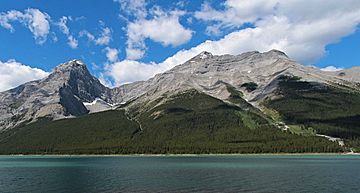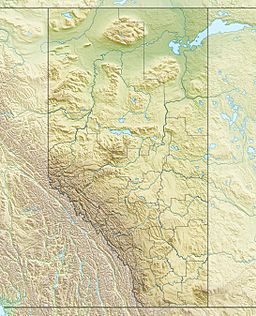Old Goat Mountain facts for kids
Quick facts for kids Old Goat Mountain |
|
|---|---|

Old Goat Mountain (right) with Mount Nestor (left)
|
|
| Highest point | |
| Elevation | 3,120 m (10,240 ft) |
| Prominence | 1,444 m (4,738 ft) |
| Parent peak | Wind Mountain (3153 m) |
| Listing | Mountains of Alberta |
| Geography | |
| Location | Alberta, Canada |
| Parent range | Goat Range, Canadian Rockies |
| Topo map | NTS 82J/14 |
| Geology | |
| Age of rock | Cambrian |
| Type of rock | sedimentary rock |
| Climbing | |
| Easiest route | Scramble |
Old Goat Mountain is a tall mountain in Kananaskis Country, Alberta, Canada. It stands about 3,120-metre (10,240 ft) high. This makes it one of the highest points in the Goat Range.
The mountain is located near the Spray Lakes Reservoir. Part of it is in Spray Valley Provincial Park. The other part is in Banff National Park. The border between these two parks runs right over the mountain's top. You can easily see Old Goat Mountain from Alberta Highway 742.
Mountain's Name
Old Goat Mountain got its name to remember Rick Collier. He was a founding member of the Old Goats Climbing Club. Rick had climbed this mountain many times. He also wrote a lot about it. Sadly, Rick Collier passed away in a climbing accident in 2012. The mountain's name is not yet officially recognized.
How the Mountain Formed
Old Goat Mountain is made of sedimentary rock. This type of rock forms from layers of sand and mud. These layers were laid down over millions of years. This happened when the area was covered by shallow seas.
Later, huge forces pushed these rock layers. This created the Canadian Rockies. This process is called the Laramide orogeny. It lifted the rocks up to form the mountains we see today.
Weather at Old Goat Mountain
The weather at Old Goat Mountain is usually cold and snowy. This is typical for a subarctic climate. Winters are very cold, with lots of snow. Temperatures can drop below −20 °C (−4 °F). With the wind, it can feel even colder, sometimes below −30 °C (−22 °F). Summers are usually mild.
When snow and ice melt, the water flows down the mountain. This water eventually drains into the Spray Lakes Reservoir.



